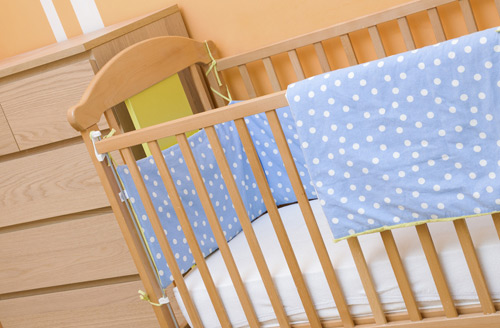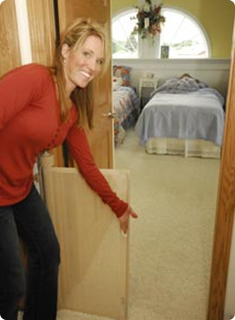Safety In The Household

Household Safety Checklist
In order to protect you and your family, a thorough safety check of every room in your home should be conducted on a regular basis. Unintentional injuries and non-traumatic emergencies may be prevented and your family will be healthier and safer when you practice a little prevention
The following checklist may be printed so it can be used for the inspection of your home.
Adult's Bedroom
- Do not leave medications, toiletries, or other household products in drawers or on night stands.
- To avoid injuries or choking, keep nail files, scissors, pen knives, earrings and pocket change out of reach.
- Install a smoke detector in the hallway outside of the bedrooms. Check and change the batteries regularly.
- Make certain drapery cords and/or blind cords are well out of reach of children and not looped.
Child's Bedroom
- Make certain the crib mattress fits snugly.
- Crib slats should be placed no wider than 2 and 3/8 inches apart.
- Make certain the crib has been put together properly and is not missing screws or bolts - to prevent it from collapsing.
- Make certain there is a carpet or rug beneath the crib or changing table to soften this impact if an infant falls.
- Make certain drapery cords and/or blind cords are well out of reach of children and cribs and do not have loops which are a strangulation hazard.
- Remove all crib gyms, hanging toys, and decorations from a crib by the time a baby can raise up on hands and knees.
- Make sure there is a safety belt on the infant changing table, and that it is used consistently and properly. Do not leave the infant unattended.
- Make sure baby powder and lotions are out of a baby or child's reach. But, make sure the baby powder and lotions are within your reach, so you do not have to leave the infant to reach these items.
- If your child can climb out of the crib, consider a youth bed with guard rails, or place the crib mattress on the floor.
- Never leave small parts or pieces of a toy(s) in a child's room.
- Make certain a night light is not near or touching drapes or the bedspread.
- Never place a crib, playpen, or bed near a window.
- Make certain window screens are securely in place, or that window guards are present - to prevent a child from falling from a window.
- Make certain there are plug protectors in the unused electrical outlets.
- If there is a lid on the toy box, it should not be heavy, hinged, or lockable. Children may crawl inside and become trapped.
Bathroom
- Put a non-skid bathmat on the floor and a nonskid mat or decals in the bathtub.
- Protect all electrical outlets with ground fault circuit interrupters.
- Store medicines, cosmetics, toiletries, and cleansers well out of reach of children.
- When children are present, put child-resistant safety latches on all cabinets storing potentially harmful substances.
- Store electrical appliances, such as hair dryers and curling irons, out of reach.
- Always unplug such an appliance before leaving it unattended, no matter how briefly.
- To avoid accidental scalding, make certain the tap water temperature is set no higher than 120 degrees Fahrenheit.
- Never leave a child or disabled person unattended in a bathtub, or in a bathroom where there is a tub, sink, or bucket containing water.
- Keep toilet lids closed to prevent drowning.
- Plug protectors
Kitchen
- Do not store vitamins (or medications) on the kitchen table, counter top, or window sill.
- Make certain knives, scissors, and other sharp utensils are out of reach or in a drawer or cabinet with a safty latch.
- Store dishwasher detergent and other cleaning supplies in their original containers and out of reach.
- When children are present, install safety latches on cabinets and drawers within a child's reach.
- Keep chairs and step stools away from counters and stoves.
- Always turn pot handles inward when cooking on the stove. Use back burners whenever possible.
- Keep the toaster out of the reach of toddlers.
- Make certain appliance cords are not dangling, so they cannot be pulled from a counter.
- Unplug appliance extension cords when not in use.
- When children are present, use plug protectors for all unused wall outlets.
- If a child is in a highchair, make sure it is sturdy and has a seat belt with a strap between the legs.
- Keep a working fire extinguisher in your kitchen.
Living Room
- Keep houseplants out of reach of children. A number of plants are poisonous.
- Make certain television sets and other heavy items are secure so they cannot be tipped over to prevent crush injuries.
- Remove unnecessary extension cords.
- Put plug protectors in any unused electrical outlets when children are present.
- Move tables and other objects with sharp edges away from the center of a room, especially if there are toddlers or disabled persons in the home.
- Place protective material on sharp furniture edges.
- Keep drapery and blind cords out of reach of children and/or disabled persons.
- Secure area rugs -- to prevent falls and slips.
Outdoors
- Keep stairs and walkways clear of snow, wet leaves, or other debris including toys.
- Repair cracks or chips in cement sidewalks and stairs.
- Make certain railings, gates, and fences are secure and in good repair.
- Keep garbage cans covered.
- There should be a fence with a locked gate between the house and the backyard swimming pool.
- Garden tools and lawn equipment should be securely stored.
- Play equipment, such as swing sets, and garden furniture should be properly anchored and assembled. Check regularly for rust, splintered wood, or cracks.

Baby Proofing
Following is a small list of the potential hazards within the home. Most babies and toddlers are very inquisitive and want to discover and explore their new world through the basic capacities available to them - eating, touching, and smelling (plus putting little things in their nose and ears!).
- Climbing up or falling down stairs
- Ingesting harmful substances (cleaning products, medicine)
- Toppling over of furniture (bookshelves, TVs, cabinets)
- Burns from stoves, hot water, or fireplaces
- Access to toilets, sinks, and trash cans
- Contact with pets, pet food bowls, litter boxes
Babyproofing should be done when your child is 3-6 months of age, or before they can crawl. There is a wide selection of safety products available to help secure individual safety hazards such as cabinet door locks, child-proof medicine bottles, faucet covers, or toilet lid locks. However, preventing your child from reaching these areas in the first place is generally the best defense towards keeping your baby safe. A good safety gate will help prevent your child from wandering where they shouldn't and will also give you some peace of mind. When shopping for a baby gate, make sure to consider the following checklist:
- Is the gate certified by the Juvenile Products Manufacturing Association (JPMA)?
- If for blocking off a stairway, is the safety gate you choose certified for stairs?
- Has the gate provider won awards for service or product quality?
- Is the gate easy to use, especially while holding your baby?
- Is the safety gate designed for high traffic areas?
- Does the gate look attractive and is it inconspicuous when not in use?
- Can the gate be moved to other areas of your home easily as needed?
- Will the safety gate be in your way when it's not being used?
- Does the gate fasten securely to the wall? Pressure-mounted gates can slip, come loose, and fall down.
Retract-A-Gate® meets ALL the above requirements and many more.
Visit their website at:
www.Retract-A-Gate.com
"Keeps Little Ones Safer"
 PREGNANCY
PREGNANCY  GIVING BIRTH
GIVING BIRTH  BABY CARE
BABY CARE  HEALTH & SAFETY
HEALTH & SAFETY  FUN STUFF
FUN STUFF  FAMILY
FAMILY 